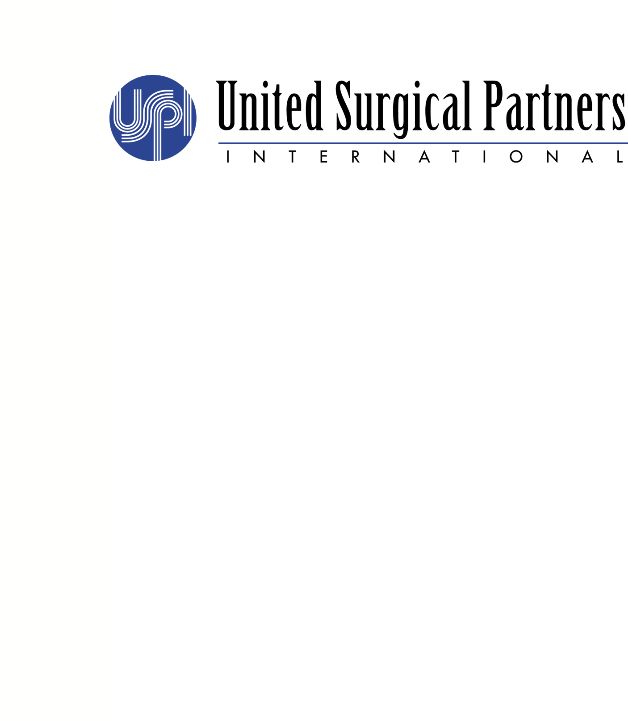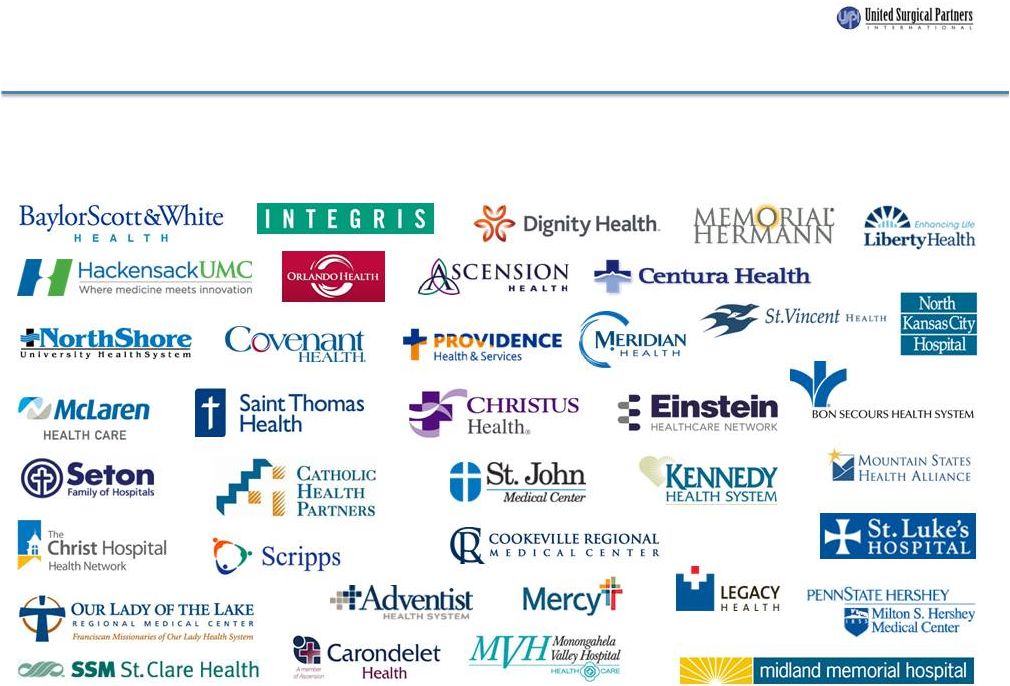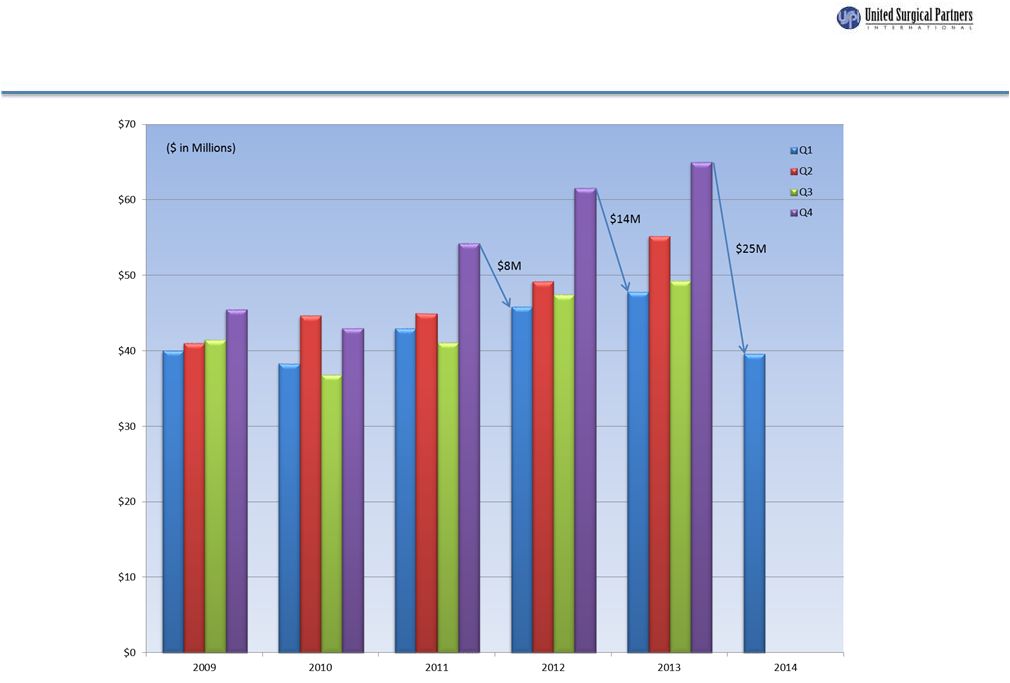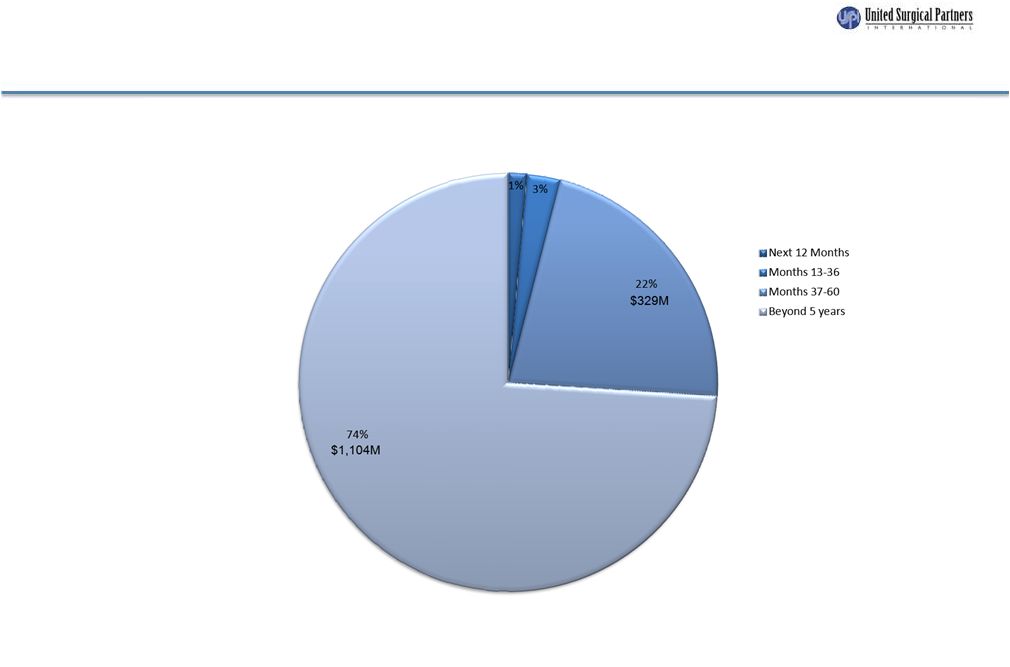Attached files
| file | filename |
|---|---|
| 8-K - FORM 8-K - UNITED SURGICAL PARTNERS INTERNATIONAL INC | d727149d8k.htm |
 May
2014 Exhibit 99.1 |
 1
Safe Harbor Statement
This presentation contains forward-looking statements, including those regarding United
Surgical Partners International, Inc. and the services it provides. Investors are
cautioned not to place an undue reliance on these forward-looking statements, which
will speak only as of the date of this presentation. United Surgical Partners
International, Inc. undertakes no obligation to publicly revise these
forward-looking statements. Non-GAAP Measurement
We use the non-GAAP financial measurement term “EBITDA.”
EBITDA is calculated as operating
income plus net gain (loss) on deconsolidations, disposals, impairments and depreciation and
amortization. USPI uses EBITDA and EBITDA less noncontrolling interests as
analytical indicators for purposes of allocating resources and assessing performance.
EBITDA is commonly used as an
analytical indicator within the health care industry and also serves as a measure of leverage
capacity and debt service ability. EBITDA should not be considered as a measure of
financial performance under generally accepted accounting principles, and the items
excluded from EBITDA could be significant components in understanding and assessing
financial performance. Because EBITDA is not a measurement determined in accordance with
generally accepted accounting principles and is thus susceptible to varying calculation
methods, EBITDA as presented by USPI may not be comparable to similarly titled measures
of other companies. |
 2
Key Highlights
$2.3+bn of revenues under management from 216 facilities performing 900,000+ cases
by ~10,000+ physician utilizers
High quality, low cost provider of surgical services
Leading operator
Leading operator
in an attractive
in an attractive
industry segment
industry segment
Proven management
Proven management
team
team
Attractive business
Attractive business
and payor mix
and payor mix
High margin, elective procedures with over half of revenue from orthopedic
specialties 78% private insurance; operating discipline yields bad debt
expense of ~2% of revenues Two-thirds of our facilities are owned in a
partnership with prominent not-for-profit healthcare systems
Provides long-term strategic stability in the market place with strong brand
reputation and stability Working with existing partners (physicians and
hospitals) to grow market share and enhance strategic positioning
Adjusted EBITDA
1
CAGR of 8% from 2006 to 2013
Cumulative Free Cash Flow
2
of $400 million from 2009 to 2013
Majority of USPI’s senior management has been with the Company over 10
years Consistent financial
Consistent financial
performance
performance
Focused on key
Focused on key
strategic markets with
strategic markets with
significant share
significant share
Unique JV partnership
Unique JV partnership
strategy
strategy
1
Consolidated Adjusted EBITDA less noncontrolling interest
2
Consolidated FCF calculated as adjusted EBITDA less capital expenditures, cash
interest, cash taxes and change in working capital (defined as increases (decreases) in cash from changes
in operating assets and liabilities, net effects from purchases of new
businesses) |
 3
Key Markets
Major Market
Facilities
USPI operates 216 facilities in 26 states
Denver
6 facilities
Centura Health
Partnership
Oklahoma City
2 facilities
INTEGRIS Health Partnership
St. Louis
17 facilities
New Jersey
14 facilities
Meridian Health
Partnership
Nashville
14 facilities
St. Thomas Partnership
Atlanta
6 facilities
Houston
21 facilities
Memorial Hermann Partnership
San Antonio/Corpus Christi
5 facilities
CHRISTUS Health Partnership
Dallas/Ft. Worth
31 facilities
Baylor Scott & White
Partnership
Phoenix/Las Vegas
14 facilities
Dignity Health
Partnership
Los Angeles
6 facilities
Dignity Health
Partnership
Kansas City
5 facilities
North Kansas City Hospital
Ascension Partnership
Chicago
4 facilities
NorthShore University
HealthSystem, Adventist
Partnership
Austin
5 facilities
Seton Partnership |
 4
Favorable Revenue and Payor Mix
High margin, elective procedures
•
53% of revenue mix from orthopedic
and pain management
Diversification of specialties insulates USPI
from negative utilization and specialty pricing
changes
78% private insurance
•
Insurance companies favor low cost
providers
•
Modest exposure to government
reimbursement fluctuations
Reliable payors and operating discipline
yields bad debt expense of ~2% of revenues
and receivable days outstanding is under 35
Low risk cash flows from high margin
specialties and reliable payors:
2013 U.S. Revenue Mix
2013 U.S. Payor Mix
Gynecology
General
ENT
GI
Cosmetic
Ophthalmology
Medical/Other
Orthopedic
Pain Mgmt
Other
Self-pay
Government
Private Insurance
4%
6%
6%
13%
2%
7%
9%
43%
10%
1%
19%
2%
78% |
 5
Strong Financial & Operating Performance Post 2007 LBO
87 acquisitions
27 de novo facility developments
18 new health system partners
Facility revenue CAGR of 13% from 2006 to 2013
Positive each of the past 5 years
Same facility revenue + 6.2% for 2011
Same facility revenue +5.7% for 2012
Same facility revenue +1.1% for 2013
Same facility revenue essentially flat in Q1 2014
Facility EBITDA CAGR of 10% from 2006 through 2013
Facility EBITDA margins of 28.9% for 2013 and 25.4% in Q1 2014
26% SWB as a percent of systemwide revenue
2% G&A as a percent of systemwide revenue
Installed and continuously improving decision support systems
Investing significantly in strategic growth infrastructure and capabilities
Improved quality management system
EHR Investment
43 facilities divested
75% of revenue from top 10 markets
Expansion
Facility revenue growth
Facility EBITDA
Cost management
System enhancements
Portfolio management |
 U.S. Industry
Overview ASCs have been widely successful and are a significant presence in the U.S.
healthcare delivery system
Advantages in patient safety and physician efficiency are meaningful
Significant savings to patients, government and commercial payors
•
Typically a savings to commercial insurers
•
Medicare savings >40%
•
Medicare beneficiary savings >50%
Able to reduce overall healthcare costs and manage need for surgical services in an integrated
care environment
Industry poised for consolidation
•
Top ten companies own less than 20%
•
Growth of new facilities has slowed in recent years
6 |
 7
Fragmented Market
Further consolidation likely within the industry and USPI is well-positioned to
capitalize There are over 375 surgery center chains that own 2 or more ASCs.
Top ten companies still own less than 20%
Some ASCs and ASC companies choosing to sell in face of current headwinds
From 2000 –
2012, the percentage of ASCs owned by a multi-facility chain increased from 22% to
40%
Source: CMS 2014 report
2000
3,172
2,468
(78%)
2,136
(36%)
3,740
(64%)
2004
3,957
2,973
(75%)
6,758
2012
2,717
(40%)
4,041
(60%)
2008
5,876
Independent
Multi-facility
USPI facilities
704
(22%)
984
(25%)
213
87
49
161 |
 8
Positioned for Reform Opportunities
Positioned to play an important role in managing increased need for surgical services
due to current reform initiatives and coverage of previously uninsured
lives |
 9
Healthcare System Partners
148 facilities are in a partnership with a healthcare system
Benefits to Healthcare Systems
Benefits to Healthcare Systems
Benefits to USPI
Benefits to USPI
Leverage USPI’s operational expertise and
singular focus
Provides a strategy to promote physician
alignment and strategic network capabilities
Provides defensive mechanism to maintain
short-stay surgical business
Provides capital and spreads risk through
USPI and physicians’
investment
Provides an opportunity to expand in new
markets at lower capital outlay than a
hospital
Provides long-term strategic stability in the
marketplace
Provides brand, image, reputation and
credibility
Accelerates growth
Enhances relationships with managed care
payors |
 Healthcare
System Partners USPI’s
strategy
of
partnering
with
not-for-profit
healthcare
systems
aligns
the
Company’s
facilities
with
strong
networks
of physicians and hospitals that are prominent in their communities and known for
providing high quality care 10 |
 Example
Facility Surgical
Facility
USPI
Hospital
Partner
Local
Physicians
Joint
Venture
49.9%
50.1%
50.1%
49.9%
~25 physician investors
Average investment per physician of $50,000
Five operating rooms
12,000 square feet
29 FTEs
60% of cases performed by physician owners
11 |
 12
Growth Strategy
Work with existing partners (physicians and hospitals) to grow market share and enhance
strategic positioning
Building direct channel capabilities
Poised
to
react
to
current
economic
conditions
and
legislative
changes
•
Acquisition of troubled facilities
•
Selective acquisition of strong facilities
•
Selective de novo development
•
Selective acquisition of multi-facility companies
Selectively enter new markets with existing or new partners
•
Attractive demographics and/or payor characteristics
•
Prominent
health
system
that
embraces
physician
alignment
strategy
•
Prominent physicians who are influential in the market
Committed to deploying capital with attractive ROI
12
12 |
 13
Sustained Revenue Growth
Systemwide revenue growth and same facility revenue growth
Same facility revenue growth
Systemwide revenue growth
Facilities
operated at
year-end
165
185
200
213
214
215
-2%
0%
2%
4%
6%
8%
10%
12%
14%
-0.3%
2011
6%
13%
2010
5%
7%
2009
8%
9%
Q1 2014
-0.2%
2013
0.7%
5.7%
2012
6%
12% |
 14
U.S. Adjusted EBITDA Bridge
($ in thousands)
2011
2012
2013
Operating income
233,659
$
245,234
$
263,791
$
Depreciation and amortization
21,177
23,955
27,238
EBITDA
254,836
269,189
291,029
Net income attributable to noncontrolling interests
(69,929)
(72,693)
(78,782)
EBITDA less noncontrolling interests
184,907
196,496
212,247
Net (gain) loss on deconsolidations, disposals and impairments
(1,529)
7,588
5,017
De novo start-up losses
4,009
500
-
Acquisition / transaction costs
3,314
2,200
200
Equity compensation
1,237
1,700
1,841
Management fee
2,000
2,000
2,000
Adjusted EBITDA
193,938
$
210,484
$
221,305
$
Years Ended December 31,
Unaudited Adjusted |
 15
Seasonality Trends |
 16
U.S. Adjusted EBITDA Bridge
($ in thousands)
2014
2013
Operating income
47,574
$
58,243
$
Depreciation and amortization
6,485
6,903
EBITDA
54,059
65,146
Net income attributable to noncontrolling interests
(15,412)
(17,240)
EBITDA less noncontrolling interests
38,647
47,906
Net loss (gain) on deconsolidations, disposals and impairments
1,014
(101)
Equity compensation
518
447
Management fee
500
500
Adjusted EBITDA
40,679
$
48,752
$
Three Months Ended March 31
Unaudited Adjusted |
 17
Debt Maturities
Total debt of $1.5 billion
•
Weighted average rate of 6.0%
•
Corporate
level
debt
service
(cash
pay)
in
the
next
12
months
is
approximately
$94M,
including
$10M
principal
and
$84M
interest |
 18
Leverage Trends
At March 31, 2014, total leverage was 6.5x and secured leverage was 4.6x
|
 19
Summary
USPI is well positioned: high quality, low cost, high customer satisfaction provider with
sound long- term strategy
Partner with prominent health systems and local physicians
Strong partnering capabilities will continue to provide opportunities for growth, even in
difficult times
Focused on key strategic markets with significant market share
Strong equity sponsor in WCAS
Capitalized for growth and flexibility |
